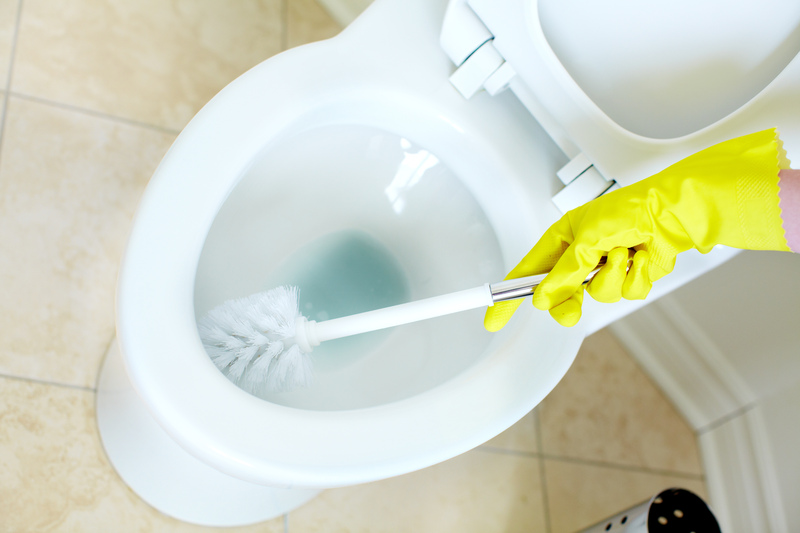Wave Farewell to Burnt-on Residue with Our Stovetop Cleaning Techniques
Posted on 04/06/2025
Wave Farewell to Burnt-on Residue with Our Stovetop Cleaning Techniques
Few sights are more disheartening in the kitchen than a once-pristine stovetop encrusted with burnt-on residue. Whether from bubbling soup, frying oil splatters, or an accidental spill-over, these stubborn stains can seem nearly impossible to remove. But don't worry - you can reclaim the sparkling brilliance of your stovetop! Discover the most effective, tried-and-true stovetop cleaning techniques and wave goodbye to burnt-on grime forever.

Why Proper Stovetop Cleaning Matters
A clean stovetop isn't just eye-pleasing - it's essential for kitchen hygiene and efficient cooking. Here's why keeping your stovetop spotless is crucial:
- Prevents food contamination: Leftover residue can harbor bacteria.
- Enhances appliance longevity: Regular deep cleans prevent corrosion and malfunction.
- Promotes even cooking: Caked-on spills may block burners and reduce efficiency.
- Makes cleaning easier: Frequent gentle cleaning reduces the need for intense, time-consuming scrubbing.
Understanding Your Stovetop: Materials & Burn Marks
Before you deploy any cleaning method, identifying your stovetop's material is essential. Treatment for enamel, stainless steel, glass, and ceramic surfaces differs vastly.
- Enamel stovetops: Durable but prone to discoloration if strong chemicals are used.
- Stainless steel: Looks gorgeous but scratches easily and may spot with harsh abrasives.
- Glass/ceramic: Sleek and modern but susceptible to scratching or cracking if cleaned improperly.
Pro tip: Always check the manufacturer's maintenance guide before starting any stovetop cleaning process.
Tools & Supplies for Stovetop Cleaning
Be prepared! Here's a checklist of what you'll need to eliminate burnt-on food and grease stains:
- Soft cleaning cloths or microfiber towels
- Sponge (non-abrasive for delicate surfaces)
- Plastic, silicone, or wooden scraper (avoid metal scrapers!)
- Old toothbrush or soft-bristled brush
- Baking soda
- White vinegar
- Dish soap (grease-cutting)
- Lemon juice (optional)
- Hydrogen peroxide (for extreme residue)
- Paper towels or disposable cleaning wipes
- Spray bottle
- Gloves (to protect your hands)
*Avoid steel wool or abrasive pads on glass and stainless steel surfaces.
Step-by-Step: Mastering Basic Stovetop Cleaning
1. Safety First - Prep Your Stovetop
- Ensure everything is cool: Cleaning a hot stovetop is dangerous and can cause burns.
- Unplug or turn off any electric components: For electric stoves, make sure all burners are off and cool to the touch.
- Remove grates and knobs: If possible, take off grates, burner caps, and knobs for separate cleaning.
2. Remove Loose Debris
- Use a paper towel or dry microfiber cloth to wipe away crumbs, food particles, or loose bits of residue.
3. Pre-Soak Stubborn Spots
- Spray burnt-on spots with a 1:1 mixture of white vinegar and water. Allow it to sit for 10-15 minutes to break down baked-on gunk.
- For severe stains, sprinkle a little baking soda directly onto the stains, then spritz with vinegar, letting it fizz for a few minutes.
4. Scrub Smart, Not Hard
- Use a soft sponge or cleaning cloth to wipe away loosened grime. For stubborn patches, gently use a plastic scraper or the edge of a wooden spatula.
- Do not use metal scrapers on glass or ceramic stovetops!
5. Tackle Burnt-On Food Residue
- Mix a paste of baking soda and water.
- Apply generously to burnt-on areas and let sit for 15-20 minutes.
- Use a non-abrasive scrubbing brush or sponge to gently work the residue off in circular motions.
6. Clean Removable Parts
- Soak grates, burner caps, and knobs in hot, soapy water for 20 minutes.
- Use a toothbrush to scrub hard-to-reach crevices.
- Rinse well and dry thoroughly before reassembling.
7. Final Rinse and Polish
- Wipe everything down with a damp, clean microfiber cloth to remove leftover cleaner or residue.
- Buff dry with a dry towel for a streak-free finish.
- For stainless steel, wipe with the grain using a drop of olive oil or special cleaner for extra shine.
Specialized Cleaning Methods for Different Stovetop Types
Cleaning Glass & Ceramic Stovetops
- Baking soda & vinegar paste: Apply gently and let fizz before wiping off. Never use abrasives!
- Cooktop scraper tool: Only use approved scrapers designed for glass surfaces.
- Commercial glass stove cleaners: These are formulated to remove residue without scratching.
Tip: For tough, burnt-on spots, lay a moist microfiber cloth over the area after applying baking soda paste and let it sit for up to 30 minutes before wiping away.
How to Clean Stainless Steel Stovetops
- Warm, soapy water: Use gentle dish soap with a microfiber cloth.
- White vinegar spray: Cuts through grease and shines the surface. Always wipe with the grain!
- Polish: Use a pea-sized drop of mineral oil or a stainless steel polish to buff for a luminous finish.
Enamel Stovetop Cleaning Techniques
- Mild abrasive paste: Mix baking soda and water for gentle scrubbing power.
- Avoid bleach: It can cause lasting discoloration to the enamel finish.
- Thorough rinse: Always ensure no cleaner is left behind to avoid sticky or streaky build-up.
Heavy-Duty Rescue: Banishing Severe Burnt-On Stovetop Residue
If you're dealing with years of caked-on gunk or severe burnt-on food residue, these advanced tricks can help:
-
Hydrogen Peroxide & Baking Soda:
- Sprinkle baking soda on worst stains, drizzle hydrogen peroxide over it, and let sit for 30 minutes.
- Scrub gently and rinse thoroughly. This method works especially well for grease spots and charred residue.
-
Lemon & Salt Scrub:
- Cut a lemon in half, sprinkle the cut side with kosher salt, and use it to scrub burnt areas. Rinse with a damp cloth.
-
Oven Cleaner (as a last resort):
- If nothing works and your stovetop material is compatible, you may carefully use an oven cleaner. Ventilate the area and follow instructions precisely.
Warning: Never mix cleaning chemicals or use anything not recommended by your stove manufacturer! Always test new cleaning products on a small, inconspicuous area first.
Preventing Burnt-On Mess: Easy Daily Habits
Keeping your stovetop gleaming is all about consistency. Incorporate these preventative tips into your daily kitchen routine to avoid burnt-on residue for good:
- Wipe spills immediately: As soon as it's safe (and your stove is cool!), blot up any overflows or splatters before they harden.
- Use burner liners: These catch spills, making cleanup a breeze. Only use liners approved for your stovetop type.
- Deep clean grates weekly: Grates easily accumulate sticky residues if ignored.
- Cook with lids when possible: This helps reduce splattering.
Green & Eco-Friendly Stovetop Cleaning
If you want to avoid harsh chemicals, good news! The most effective burnt-on food cleaning solutions are also kitchen-shelf staples:
- Baking soda: Safe, gentle abrasive action.
- White vinegar: Naturally cuts grease and leaves a streak-free finish.
- Lemon juice: Natural degreaser and deodorizer.
These are non-toxic, affordable, and earth-friendly - perfect for the health-conscious chef.
Common Stovetop Cleaning Mistakes to Avoid
- Not waiting for cool-down: Attempting to clean a hot surface leads to burns and may cause certain cleaners to evaporate before working.
- Using abrasive pads or steel wool: These scratch and damage delicate surfaces.
- Letting stains "soak in" too long: Stubborn stains become exponentially harder to remove over time.
- Ignoring the manufacturer's directions: Some surfaces require specific products or methods to avoid voiding warranties or causing irreversible damage.
Caring for Your Stovetop Long Term
- Inspect after each use: Clean minor spills right away to prevent build-up.
- Deep clean once a week: Make stovetop scrubbing part of your kitchen routine.
- Check and maintain burners: Ensure ports are clear for even, safe cooking.
- Store cleaners safely: Keep kid- and pet-safe cleaning products on hand for frequent use.

When to Call in the Professionals
Occasionally, stovetop residue is simply too stubborn, or there's a risk of internal electrical damage. If you experience:
- Residue or stains beneath sealed glass/ceramic cooktops
- Consistent ignition problems after cleaning
- Burn marks or warping of burner components
It's best to contact a qualified appliance technician to avoid further damage or voiding your stove's warranty.
Conclusion: Embrace a Sparkling Stovetop, Effortlessly
Burnt-on residue doesn't have to be the bane of your kitchen's existence. With these comprehensive stovetop cleaning techniques and proven cleaning solutions, you can wave farewell to burnt-on food and grime for a spotlessly shiny stove, every time.
Consistency and the right supplies are key to day-to-day maintenance and hassle-free deep cleans. Say goodbye to scraping, sweating, and endless scrubbing - a gleaming, inviting stovetop is well within your reach!
If you found these stovetop residue removal tips helpful, be sure to browse our other kitchen cleaning guides to keep your entire cooking space sparkling clean and inviting. Happy cleaning!





